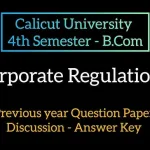Download punjab pniversity question papers for MA-English, MA-History, MCA, and MBA. These punjab pniversity previous year question papers are important study resources that help you prepare for your exams.
Practicing these old papers will give you a good idea of the exam pattern and types of questions asked. Enhance your exam preparation by downloading and studying these papers.
MA-English PU Old Papers with Answers
For MA-English, you’ll find questions on British and American literature.
Question: Discuss the themes of colonialism and post-colonialism in Joseph Conrad’s “Heart of Darkness”.
Answer: “Heart of Darkness” explores themes of colonialism through the journey of Marlow into the African Congo, highlighting the exploitation and brutality faced by the indigenous population under European imperial rule. Post-colonialism is reflected in the critique of colonial enterprises and the moral ambiguity surrounding the so-called “civilizing mission”.
Question: How does T.S. Eliot use fragmentation in “The Waste Land”?
Answer: Eliot employs fragmentation to depict the chaos and disillusionment of the post-World War I era. Through disjointed narratives, multiple voices, and allusions to various texts, he mirrors the fractured nature of modern society.
Question: Compare and contrast the character of Elizabeth Bennet in “Pride and Prejudice” with that of Jane Eyre in “Jane Eyre”.
Answer: Elizabeth Bennet is witty, intelligent, and values personal integrity, challenging societal norms of marriage. Jane Eyre, on the other hand, is passionate, strong-willed, and seeks independence, despite societal constraints, showcasing resilience and self-respect.
Question: Explain the concept of “negative capability” as articulated by John Keats.
Answer: “Negative capability” refers to the poet’s ability to accept uncertainty and ambiguity without the urge to rationalize. For Keats, it meant embracing the mysteries of life and the beauty of unresolvable contradictions.
Question: Analyze the role of fate in Thomas Hardy’s “Tess of the d’Urbervilles”.
Answer: Fate plays a crucial role in Tess’s life, dictating her misfortunes and tragic destiny. Hardy presents fate as an inescapable force that shapes Tess’s life, often in the form of societal expectations and moral judgments.
Question: Discuss the use of symbolism in “The Great Gatsby” by F. Scott Fitzgerald.
Answer: Fitzgerald uses symbolism extensively, such as the green light representing Gatsby’s unattainable dreams, the Valley of Ashes symbolizing moral decay, and the eyes of Dr. T.J. Eckleburg representing the omnipresence of judgment.
Question: How does Virginia Woolf address the theme of time in “Mrs Dalloway”?
Answer: Woolf addresses time through the novel’s structure, using stream of consciousness to shift between past and present. The clock chimes mark the passage of time, reflecting the characters’ preoccupation with their past and the fleeting nature of life.
Question: Examine the role of nature in William Wordsworth’s poetry.
Answer: Wordsworth views nature as a source of inspiration, solace, and moral guidance. His poetry often celebrates the beauty of the natural world and its ability to nurture the human spirit and provide a connection to the divine.
Question: What are the major themes in Chinua Achebe’s “Things Fall Apart”?
Answer: Major themes include the clash of cultures, the impact of colonialism, the struggle between tradition and change, and the individual versus community. Achebe portrays the disruption of Igbo society by European colonizers and the resulting cultural disintegration.
Question: Discuss the use of irony in Jane Austen’s “Emma”.
Answer: Austen employs irony to critique social structures and character flaws. Emma’s misguided matchmaking and misinterpretations highlight her naivety and overconfidence, while the narrative irony allows readers to see the disparity between Emma’s perception and reality.
[save_as_pdf_pdfcrowd]
MA-History PU Old Papers with Answers
MA-History papers cover ancient, medieval, and modern history.
Question: Discuss the causes and consequences of the French Revolution.
Answer: Causes include social inequality, financial crises, Enlightenment ideas, and political mismanagement. Consequences were the rise of Napoleon, the spread of revolutionary ideals, and significant social and political changes in France and beyond.
Question: Analyze the impact of the Industrial Revolution on European society.
Answer: The Industrial Revolution led to urbanization, changes in labor systems, technological advancements, and significant social shifts. It also caused environmental changes, increased productivity, and created a new class structure.
Question: Evaluate the significance of the Treaty of Versailles in the context of World War I.
Answer: The Treaty of Versailles officially ended WWI, imposed heavy reparations on Germany, and redrew European borders. It created economic hardship and political instability in Germany, contributing to the rise of Nazism and WWII.
Question: Describe the main features of the Renaissance.
Answer: The Renaissance was characterized by a revival of classical learning, humanism, artistic innovation, and scientific exploration. It marked a shift towards secularism and individualism in European culture.
Question: What were the causes and effects of the American Civil War?
Answer: Causes included slavery, states’ rights, and economic differences between the North and South. Effects were the abolition of slavery, the preservation of the Union, and significant social and economic changes in the post-war period.
Question: Assess the impact of colonialism on Africa.
Answer: Colonialism led to the exploitation of African resources, the imposition of European political structures, cultural changes, and significant social disruptions. It also set the stage for modern-day conflicts and economic challenges.
Question: Discuss the unification of Germany under Bismarck.
Answer: Otto von Bismarck used diplomacy, wars, and political strategies to unify German states under Prussian leadership. His Realpolitik and manipulation of European alliances were key in achieving unification by 1871.
Question: Explain the causes and outcomes of the Russian Revolution of 1917.
Answer: Causes included widespread discontent, economic hardship, and the impact of WWI. Outcomes were the overthrow of the Tsar, the rise of the Bolsheviks, and the establishment of a communist government in Russia.
Question: Analyze the role of Gandhi in the Indian independence movement.
Answer: Gandhi advocated for non-violent resistance and civil disobedience, uniting diverse groups in the struggle for independence. His leadership and strategies were crucial in mobilizing mass support and pressuring the British to grant independence.
Question: Discuss the Cold War’s impact on global politics.
Answer: The Cold War led to geopolitical tension between the US and the USSR, influencing international alliances, military strategies, and conflicts like the Korean and Vietnam Wars. It also spurred technological advancements and space exploration.
[save_as_pdf_pdfcrowd]
MCA (Master of Computer Applications) PU Old Papers with Answers
MCA papers include programming and software engineering questions.
Question: Explain the difference between procedural and object-oriented programming.
Answer: Procedural programming focuses on procedures or routines to perform tasks, while object-oriented programming is based on objects that encapsulate data and functions. OOP promotes reusability, scalability, and modularity.
Question: Describe the process of normalization in a relational database.
Answer: Normalization is the process of organizing data to reduce redundancy and improve integrity. It involves decomposing tables into smaller, related tables and defining relationships to ensure data consistency and minimize duplication.
Question: What are the key features of the Java programming language?
Answer: Java is platform-independent, object-oriented, and secure. It supports multithreading, automatic memory management (garbage collection), and a rich standard library.
Question: Compare and contrast TCP and UDP protocols.
Answer: TCP is connection-oriented, ensuring reliable data transmission with error checking and flow control. UDP is connectionless, providing faster transmission without guaranteeing delivery, making it suitable for real-time applications.
Question: What is a deadlock in operating systems, and how can it be prevented?
Answer: A deadlock occurs when processes wait indefinitely for resources held by each other. Prevention methods include resource allocation strategies like avoiding circular wait, ensuring a single lock order, and using timeouts.
Question: Explain the concept of inheritance in object-oriented programming.
Answer: Inheritance allows a class to inherit properties and methods from another class, promoting code reusability and hierarchical relationships. It enables the creation of a derived class based on an existing base class.
Question: What are the primary functions of an operating system?
Answer: An operating system manages hardware resources, provides a user interface, and facilitates the execution of applications. Key functions include process management, memory management, file system management, and device control.
Question: Discuss the differences between SQL and NoSQL databases.
Answer: SQL databases use structured schemas and support ACID transactions, making them suitable for complex queries and consistency. NoSQL databases offer flexible schemas, horizontal scaling, and are optimized for unstructured data and high-performance scenarios.
Question: How does the Agile methodology differ from the Waterfall model in software development?
Answer: Agile emphasizes iterative development, flexibility, and customer collaboration, allowing for changes throughout the project. The Waterfall model follows a linear, sequential approach with distinct phases, making it less adaptable to changes once a phase is completed.
Question: What is a binary search algorithm, and how does it work?
Answer: Binary search is an efficient algorithm for finding an element in a sorted array. It works by repeatedly dividing the search interval in half, comparing the target value to the middle element, and narrowing the interval based on the comparison.
[save_as_pdf_pdfcrowd]
MBA (Master of Business Administration) PU Old Papers with Answers
MBA papers focus on marketing, finance, and human resources.
Question: Explain Porter’s Five Forces model.
Answer: Porter’s Five Forces model analyzes the competitive forces within an industry: the threat of new entrants, the bargaining power of suppliers, the bargaining power of buyers, the threat of substitute products or services, and industry rivalry.
Question: What are the main components of a marketing mix?
Answer: The marketing mix consists of the Four Ps: Product, Price, Place, and Promotion. These elements are used to develop a comprehensive marketing strategy that meets customer needs and achieves business objectives.
Question: Discuss the significance of SWOT analysis in strategic planning.
Answer: SWOT analysis identifies an organization’s Strengths, Weaknesses, Opportunities, and Threats. It helps in strategic planning by providing insights into internal capabilities and external factors, guiding decision-making and strategy formulation.
Question: Compare and contrast equity financing and debt financing.
Answer: Equity financing involves raising capital by issuing shares, giving investors ownership stakes. Debt financing involves borrowing funds, typically through loans or bonds, which must be repaid with interest. Equity financing dilutes ownership but avoids debt obligations, while debt financing maintains ownership but increases financial risk.
Question: What is the Balanced Scorecard, and how is it used in performance management?
Answer: The Balanced Scorecard is a strategic management tool that measures organizational performance across four perspectives: financial, customer, internal processes, and learning and growth. It helps align business activities with vision and strategy, providing a comprehensive view of performance.
Question: Describe the stages of the product life cycle.
Answer: The product life cycle consists of four stages: Introduction (product launch and initial marketing), Growth (increasing sales and market acceptance), Maturity (sales peak and market saturation), and Decline (decreasing sales and market relevance).
Question: Explain the concept of corporate social responsibility (CSR).
Answer: CSR refers to a company’s commitment to ethical practices, social welfare, and environmental sustainability. It involves actions beyond profit-making, such as community engagement, fair labor practices, and reducing environmental impact.
Question: What are the advantages and disadvantages of a matrix organizational structure?
Answer: Advantages include flexible resource allocation, enhanced collaboration, and improved project management. Disadvantages include potential confusion from dual reporting lines, conflicts of interest, and increased complexity in decision-making.
Question: Discuss the role of leadership in organizational change.
Answer: Effective leadership is crucial in guiding organizations through change by providing vision, fostering a supportive culture, communicating clearly, and motivating employees. Leaders must manage resistance, align stakeholders, and ensure a smooth transition.
Question: What is the significance of financial ratio analysis?
Answer: Financial ratio analysis evaluates a company’s financial health and performance by comparing different financial metrics. It helps stakeholders assess profitability, liquidity, solvency, and efficiency, guiding investment decisions and strategic planning.
[save_as_pdf_pdfcrowd]
Exam Pattern
- MA English (Master of Arts in English):
- Duration: 2 years (4 semesters)
- Type: Semester system
- Subjects: British Literature, American Literature, Linguistics, Literary Theory, etc.
- Question Types: Essay, short answer, critical analysis, and literary criticism
- MA History (Master of Arts in History):
- Duration: 2 years (4 semesters)
- Type: Semester system
- Subjects: Ancient History, Medieval History, Modern History, World History, etc.
- Question Types: Long answer, short answer, essay, and historical analysis
- MCA (Master of Computer Applications):
- Duration: 3 years (6 semesters)
- Type: Semester system
- Subjects: Programming, Database Management, Software Engineering, Networking, etc.
- Question Types: Objective, short answer, programming assignments, and practical exams
- MBA (Master of Business Administration):
- Duration: 2 years (4 semesters)
- Type: Semester system
- Subjects: Marketing, Finance, Human Resources, Operations Management, etc.
- Question Types: Case studies, problem-solving, essay, and analytical questions
Note:
- Each course may have specific variations in the exam pattern depending on the semester and subjects offered.
- Practical exams for MCA include programming assignments and lab work in addition to theory exams.
Latest Posts
- Step-by-step guide to download and apply for jee mains admit card 202
- Comprehensive 2025 government holidays and recruitment details for job seekers
- JEE Mains Admit Card 2025: Your Step-by-Step Guide to Downloading the Hall Ticket
- Everything You Need to Know About 2025 Government Holidays Recruitment
- Comprehensive Guide to rrb d group recruitment 2025 – Eligibility, Vacancies, and Application
- Detailed guide to nps trust recruitment 2025 vacancies, eligibility and apply process
- Comprehensive guide to hpcl recruitment 2025 notification, vacancies, and application process
- ignou bed admission 2025 complete recruitment guide with eligibility and process
- Comprehensive Guide to Indian Army Agniveer Recruitment 2025 Notification and Jobs
- Everything You Must Know About CBSE Board Exams 2025 Changes & New Rules





